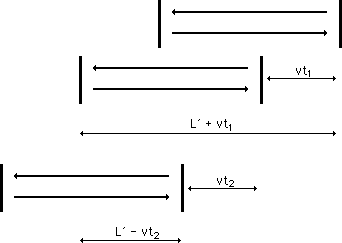Experiment --> 1
2 3 4
5 6 7 8
9
Experiment
5
A light clock lies on its side on a railroad car as the car moves to the left
with velocity v.

Question: How is the length of the clock affected?
Answer:
We
know that the time between ticks on the moving clock, as we see it, will be tī
=
 . Let,
. Let,
t1
= time that takes the light to go from the first mirror to the second , as we
perceive it.
t2 = time that it takes the light to go from the second mirror back
to the first, as we perceive it.
Lī= length of the light clock, as we perceive it.
We
can analyze the situation as follows:

From the above picture we see that the distance the light traveled in time t1
was Lī+ vt1. However, this distance is also equal to ct1
(rate x time). Also, the distance the light traveled on the return trip
was Lī- vt2 = ct2. Solving for t1, we have
Lī+
vt1 = ct1
which implies that Lī= ct1 - vt1,
which implies Lī= (c - v)t1,
which implies t1 =
 .
.
Similarly,
Lī-
vt2 = ct2
which implies that Lī= ct2 + vt2,
which implies Lī= (c + v)t2,
which implies t2 =
 .
.
Thus,
tī
= t1 + t2
=

=

=

which implies that
 =
=
 .
.
Since
t = (2L)/c,
 =
=

which implies that
 =
=
 ,
,
which implies
 =
=
 ,
,
which implies
 =
=
 ,
,
which implies Lī = L
 .
.
Conclusion:
Since
 is less
than 1, this shows that we will measure the length of his light clock as being
less than ours. Thus, when an object is moving in a straight line with a fixed
velocity v, we will see its length, as measured in the direction in which it is
moving, shorten.
is less
than 1, this shows that we will measure the length of his light clock as being
less than ours. Thus, when an object is moving in a straight line with a fixed
velocity v, we will see its length, as measured in the direction in which it is
moving, shorten.